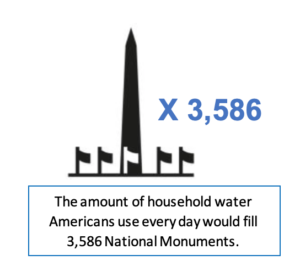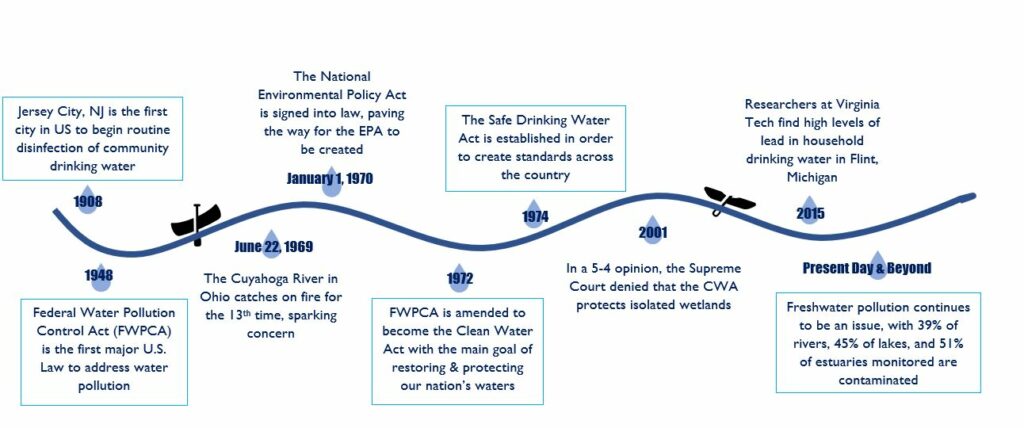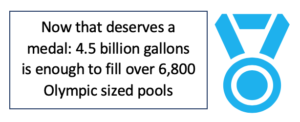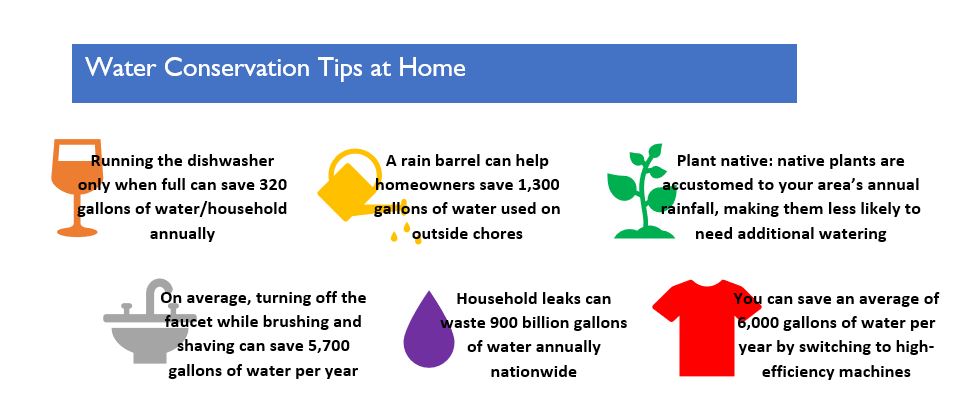May is Home to National Drinking Water Week
The then & now of clean drinking water
By Cassidy Quistorff
The total amount of water on Earth has stayed the same for approximately two billion years. Of the 326 million trillion gallons of water present on Earth, less than 1% is accessible and drinkable. Given that water is an essential component for life on Earth, it seems only fitting to have at least one week designated to it. National Drinking Water Week may not be as popular as “National Donut Day” (free donuts, hard to compete), but it marks an important celebratory milestone in the history of freshwater in our country.

This designation was made possible by a coalition of organizations, including the American Water Works Association, League of Women Voters, and the U.S. Environmental Protection Agency. After it was brought to the attention of government officials in 1988, it was passed in a joint congressional resolution and May 2nd-8th was declared National Drinking Water Week by President Ronald Reagan.
The proclamation begins by referencing the more than “12 billion gallons of drinking water” used daily in the country. However, over the past forty years, that number has more than doubled to approximately 28.8 billion gallons of clean water used every day. If you include industrial and agricultural use, that number jumps to 281 billion gallons of freshwater used in a single day.
“Today, behind every drop of good drinking water are dedicated individuals such as scientists, engineers, elected officials, water plant owners and operators, regulatory officials, and citizen groups, whose unceasing efforts allow us to enjoy the world’s best drinking water.”
President Ronald Reagan, Proclamation 5809
The above text from the proclamation is applicable now more than ever, with drinking water and wastewater treatment employees continuing work during the COVID-19 pandemic. Over 1.7 million U.S. workers are directly tied to water utility infrastructure. “Water professionals are doing heroic work to keep water flowing and assure that citizens stay hydrated, wash their hands and prevent the spread of COVID-19,” said American Water Works Association CEO David LaFrance. Based on current evidence, the risk to water supplies from the virus is low.
When drinking water systems were first designed, however, outbreaks of a different kind were on the mind. In 1900, epidemics of waterborne diseases were a major public health threat in the U.S. At the time, typhoid fever had an infection rate of 100 cases per 100,000 people. After the widespread construction of water treatment facilities, infection rates of waterborne diseases decreased dramatically. Today, typhoid fever is no longer prevalent in the U.S., with an infection rate of 0 per 100,000 people. Further attention to other harmful agents in drinking water was considered in 1974 with the Safe Drinking Water Act (SDWA). The premise behind the SDWA was eponymous: ensure tap water was safe for all.

Unfortunately, 46 years later, it still hasn’t guaranteed safe, clean water for everyone.
According to data from the EPA, more than 30 million Americans lived in areas where water systems violated safety rules at the beginning of 2019. The causes are geographically dependent, from old pipes and legacy contamination to poor wastewater treatment infrastructures. Perhaps the most well-known case of contaminated drinking water in the past decade is Flint, Michigan. After residents complained of the color, taste, and odor of their drinking water, researchers from Virginia Tech were called in to do water quality research. Their results showed that over 17% of the tested water had an “action level” of lead contamination. In addition, the water also tested positive for fecal coliform bacteria and cancer-causing chemicals.
This issue expands farther than just Michigan, highlighting the need for an upgrade in our water infrastructure. According to the EPA’s most recent needs survey, over the next 20 years the U.S. must invest at least $369.5 billion for wastewater/ stormwater upgrades and $472.6 billion for drinking water upgrades.
Virginia faces its own set of challenges to clean water in the future. For one, sea level rise along Virginia’s coastal zone could cause saltwater contamination in drinking water if proper infrastructure is not updated or installed. Possible increased rainfall and runoff could also cause further contamination to already polluted rivers. The stormwater and flooding are primarily an issue of presenting water volumes that overwhelm wastewater treatment facilities. Even now, Virginia’s marshes and wetlands are showing the impacts of climate change on freshwater. Wetlands are crucial to clean freshwater as they remove sediment and contaminants, but salt intrusion from the ocean is killing off wetland trees, creating dead zones known as “ghost forests”.
Although the East is generally thought of as a “wet” area, at least thirteen states expect to see water shortages at local or regional scales in the next ten years. In the state of Virginia alone, roughly 600 million gallons of water are used domestically every day. That’s about 75 gallons per resident daily. In terms of water conservation, every drop saved helps. That’s why calculating your water footprint and knowing areas you can consume less is a great resource for anyone. If each Virginia resident reduced their shower time by a minute, that would save 4.5 billion gallons of water each year!

While National Drinking Water Week itself has not created any long-term policy effects, it is celebrated by many local governments and authorities. Some of the events include art contests, photography shows, and educational outreach opportunities. In addition, local leaders and politicians use it as a platform to show support for clean water. Though many of the events were cancelled this year, there are still plenty of ways to show your love of clean water at home, even if that’s just by using a little less.

For more information on Waters of the United States from the Virginia Water Radio: http://www.virginiawaterradio.org/2015/06/episode-269-6-8-15-what-are-waters-of.html
For more information on Virginia’s State Water Resources Plan from the Virginia Water Radio: http://www.virginiawaterradio.org/2015/04/episode-261-4-13-15-virginias-state.html
For more information on communities without access to safe water: https://time.com/longform/clean-water-access-united-states/
